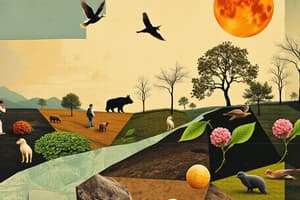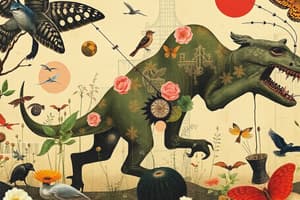Podcast
Questions and Answers
What is the primary distinction between a food chain and a food web?
What is the primary distinction between a food chain and a food web?
- A food chain includes both biotic and abiotic factors, while a food web includes only biotic factors.
- A food chain is limited to one species, while a food web can involve multiple species.
- A food chain shows energy flow, while a food web is a more complex network. (correct)
- A food web shows the energy flow, while a food chain represents only producer to consumer relationships.
Which of the following best defines the term 'ecosystem'?
Which of the following best defines the term 'ecosystem'?
- A collection of similar species living in the same area.
- An interaction among organisms in a specific environment involving both living and non-living components. (correct)
- A community of organisms interacting with one another only.
- A large region characterized by specific types of flora and fauna.
What type of interaction is defined as one organism benefiting at the expense of another?
What type of interaction is defined as one organism benefiting at the expense of another?
- Predation
- Mutualism
- Parasitism (correct)
- Commensalism
Which of these is an example of a prokaryotic organism?
Which of these is an example of a prokaryotic organism?
What is the significance of nutrient cycles in an ecosystem?
What is the significance of nutrient cycles in an ecosystem?
Which characteristic of a population refers to the number of individuals living in a specific area?
Which characteristic of a population refers to the number of individuals living in a specific area?
Which process involves a single organism reproducing without combining genetic material?
Which process involves a single organism reproducing without combining genetic material?
Which classification includes both single-celled and multicelled organisms?
Which classification includes both single-celled and multicelled organisms?
Flashcards are hidden until you start studying
Study Notes
Ecology
- Definition: Study of interactions between organisms and their environment.
- Key Concepts:
- Ecosystems: Composed of biotic (living) and abiotic (non-living) components.
- Biomes: Large regions characterized by climate and specific types of flora and fauna (e.g., tundra, rainforest).
- Food Chains & Webs:
- Food Chain: Linear sequence showing energy flow (e.g., producer → consumer → decomposer).
- Food Web: Complex network of feeding relationships in an ecosystem.
- Nutrient Cycles: Movement of nutrients through ecosystems (e.g., carbon cycle, nitrogen cycle).
- Biological Interactions:
- Predation: One organism (predator) feeds on another (prey).
- Competition: Organisms compete for the same resources (e.g., food, habitat).
- Symbiosis: Close interactions between species (e.g., mutualism, commensalism, parasitism).
Organisms
- Classification: Organisms categorized into domains and kingdoms based on characteristics.
- Domains: Bacteria, Archaea, Eukarya.
- Kingdoms: Includes Animalia, Plantae, Fungi, and Protista.
- Cell Types:
- Prokaryotic: Simple, single-celled (e.g., bacteria).
- Eukaryotic: Complex, can be single or multicellular (e.g., plants, animals, fungi).
- Life Processes:
- Metabolism: Total chemical reactions for energy management (catabolism and anabolism).
- Reproduction:
- Asexual: Single organism reproduces (e.g., binary fission, budding).
- Sexual: Two organisms contribute genetic material (e.g., fertilization).
- Adaptation: Changes in organisms over time to better survive in their environments.
Population
- Definition: Group of individuals of the same species living in a specific area.
- Population Characteristics:
- Density: Number of individuals per unit area.
- Distribution: How individuals are spaced (e.g., clumped, uniform, random).
- Size: Total number of individuals in a population.
- Growth Models:
- Exponential Growth: Population increases rapidly under ideal conditions (J-shaped curve).
- Logistic Growth: Growth slows as carrying capacity is reached (S-shaped curve).
- Carrying Capacity: Maximum population size that an environment can sustain.
- Population Dynamics:
- Birth and Death Rates: Influences population size and structure.
- Immigration and Emigration: Movement of individuals into or out of a population, affecting size and genetic diversity.
Ecology
- Definition: Interaction study between organisms and their environment.
- Ecosystems consist of both biotic (living) and abiotic (non-living) components.
- Biomes are large regions, defined by climate, and characterized by distinct flora and fauna (examples include tundra and rainforest).
- Food chains represent energy flow in a linear sequence: producer → consumer → decomposer.
- Food webs illustrate the complex relationships of feeding among species in an ecosystem.
- Nutrient cycles, such as the carbon cycle and nitrogen cycle, demonstrate how nutrients circulate through ecosystems.
- Biological interactions include predation (predator-prey dynamics), competition for resources (e.g., food, habitat), and symbiosis (mutualism, commensalism, parasitism).
Organisms
- Classification arranges organisms into domains and kingdoms based on characteristics.
- Three domains: Bacteria, Archaea, and Eukarya.
- Kingdoms under Eukarya include Animalia, Plantae, Fungi, and Protista.
- Organisms are categorized as prokaryotic (simple, single-celled, e.g., bacteria) or eukaryotic (complex, single or multicellular, e.g., plants, animals, fungi).
- Metabolism encompasses all chemical reactions for energy management, divided into catabolism (breaking down) and anabolism (building up).
- Reproduction can be asexual (single organism methods like binary fission or budding) or sexual (genetic contribution from two organisms via fertilization).
- Adaptation refers to evolutionary changes in organisms, enhancing survival in their respective environments.
Population
- Definition: A population consists of individuals of the same species living in a specific geographic area.
- Population characteristics include density (individuals per unit area), distribution patterns (clumped, uniform, random), and size (total number of individuals).
- Growth models illustrate population increases:
- Exponential growth occurs under ideal conditions, resulting in a J-shaped curve.
- Logistic growth shows a slowdown as the carrying capacity of the environment is approached, resulting in an S-shaped curve.
- Carrying capacity is the maximum population size that an environment can sustainably support.
- Population dynamics are influenced by birth and death rates, as well as immigration and emigration, affecting size and genetic diversity.
Studying That Suits You
Use AI to generate personalized quizzes and flashcards to suit your learning preferences.




